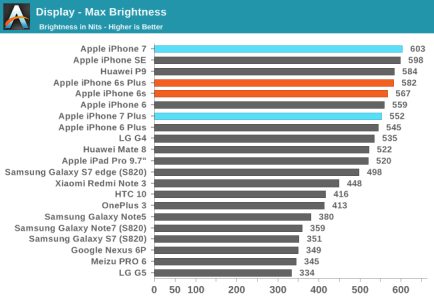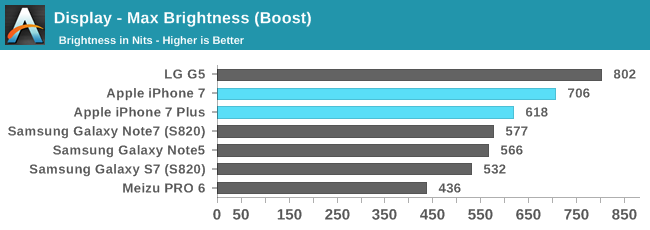Re: iPhone vs Pixel XL...
Is brightness the only measure of better?
Because the Note 7 has a better display.
Is brightness the only measure of better?
Because the Note 7 has a better display.
Yes, I was going off of memory. With auto on, the Note 7 gets almost 300 nits brighter than the iPhone 7. The Anandtech tests make no mention of that. Most people are going to use auto brightness.
Because the Note 7 has a better display.


I'm not wrong. They're from Displaymate.
iPhone 7 Display Technology Shoot-Out
Again, that's just wrong. They test with auto on and off and have tables for both.
You're literally ignoring and/or denying facts so that your position is the correct one. When IN FACT it is not.
The Note 7 is dead. It could have a million nits of brightness and infinite color range. Doesn't matter, can't buy it. Move on.
I would argue that brightness cannot be the most important measurement of a display
The numbers hitting 1,000 nits are copied & pasted here.
Measured Auto Brightness
in High Ambient Light
with Automatic Brightness On
Auto Brightness
569 – 1,048 cd/m2
Excellent
Auto Brightness
569 – 1,048 cd/m2
Excellent
Auto Brightness
569 – 1,048 cd/m2
Excellent
Some displays including the Galaxy Note7 have
higher Brightness in Automatic Brightness Mode.
Galaxy Note7 OLED Display Technology Shoot-Out
No, but the Note 7 has better contrast, better brightness, and a higher resolution while also being comparable to the iPhone 7 in any other metric.Is brightness the only measure of better?
Again, that's just wrong. They test with auto on and off and have tables for both.
You're literally ignoring and/or denying facts so that your position is the correct one. When IN FACT it is not.
The Note 7 is dead. It could have a million nits of brightness and infinite color range. Doesn't matter, can't buy it. Move on.
View attachment 242182
View attachment 242183
The numbers hitting 1,000 nits are copied & pasted here.
Measured Auto Brightness
in High Ambient Light
with Automatic Brightness On
Auto Brightness
569 – 1,048 cd/m2
Excellent
Auto Brightness
569 – 1,048 cd/m2
Excellent
Auto Brightness
569 – 1,048 cd/m2
Excellent
Some displays including the Galaxy Note7 have
higher Brightness in Automatic Brightness Mode.
Galaxy Note7 OLED Display Technology Shoot-Out
I linked to Displaymate's review of the iPhone 7 display - Anandtech is wrong.
No, but the Note 7 has better contrast, better brightness, and a higher resolution while also being comparable to the iPhone 7 in any other metric.
What I said is not wrong. I linked to Displaymate's review of the iPhone 7 display - Anandtech is wrong.
The Note 7 didn't just disappear. People still own it and the product was sold so it is still fair game. We do it all the time for other products.
How are they wrong? Do you know this for a fact or is it because Displaymate supports your view so therefore Anandtech has to then be wrong?
You have no idea if Anandtech is more neutral or not. I can tell you that the Displaymate reviews are written by Dr. Raymond Soneira who has a PhD in theoretical physics from Princeton and whose business is based around evaluating displays. The Anandtech display review was written by Brandon Chester, who may or may not be a 20-something software engineer in Canada.Let's be honest, displaymate results are questionable to begin with because of their business practices.
He's choosing to use those results though since they are the only ones that show the Note 7 display as better in any meaningful. I'm not trying to bash the Note 7 display, I loved it when I had it and Basic Mode is super accurate. The other modes don't matter since the OS doesn't have the ability to properly support them.
But the iPhone is MORE accurate, has proper DCI-P3 support AT THE OS LEVEL, gets BRIGHTER according to testing that is more neutral than displaymate, and has BETTER usable brightness in bright conditions. We could argue that both are accurate enough to not see the difference, but we're discussing the technical measurements here and not real world use.
None of that is to take away from the Note 7 capabilities. But the display is also technically more capable than the OS that drives it, which is really what the limiting factor is.
Also, Note 7 is dead so not sure why it's still being used for comparisons.
Yep, 569, which is lower than the 705 that the iPhone has to 1048, which is higher. Anand records these values at 577 and 706 respectively, so they agree.
Measured full brightness (not on auto) is 410 on display mate for the Note 7 and 359 on anand, so similar but clearly different while full for the iphone is 602 on display mate and 603 on anand, clearly agree.
So if we use the best numbers the Note and the worst for the iPhone we get this:
Note 7 Max Brightness with Slider: 410
Note 7 Max Brightness on Auto: 577
iPhone 7 Max Brightness with Slider: 602
iPhone 7 Max Brightness on Auto: 705
There is no way that Displaymate was off the mark by 471 nits. By the way, your question could be posed to those who are disagreeing with me as wellHow are they wrong? Do you know this for a fact or is it because Displaymate supports your view so therefore Anandtech has to then be wrong?
You have no idea if Anandtech is more neutral or not. I can tell you that the Displaymate reviews are written by Dr. Raymond Soneira who has a PhD in theoretical physics from Princeton and whose business is based around evaluating displays. The Anandtech display review was written by Brandon Chester, who may or may not be a 20-something software engineer in Canada.
Max brightness for the Note 7 is 1,048 nits. Not 577 nits.
There is no way that Displaymate was off the mark by 471 nits. By the way, your question could be posed to those who are disagreeing with me as well
You have no idea if Anandtech is more neutral or not. I can tell you that the Displaymate reviews are written by Dr. Raymond Soneira who has a PhD in theoretical physics from Princeton and whose business is based around evaluating displays. The Anandtech display review was written by Brandon Chester, who may or may not be a 20-something software engineer in Canada.
Their business model does not imply that they are unethical nor does Anandtech's business model show that they are ethical.Actually I do. All you need to do is some research into the business model of displaymate.
But again, I don't expect you to do that because that won't support your narrative. Facts seem to not matter to you like they should.
Max brightness for the Note 7 is 1,048 nits. Not 577 nits.

